|
The
Omega Flightmaster - a brief
overview...
|
- Written
by Chuck
Maddox
 on 7 February 2001,
on 7 February 2001,
- Last
Revised: 19 September, 2005,
14:49
GMT
- Certain
Rights
Reserved...
|
-
|
- [Recently
in the Omega Forum a poster
asked for information on the
Omega Flightmaster.
- With
precious little information
available about this watch I
wrote up the following brief
overview]
|
|
|
The
Flightmaster...

|
The
Flightmaster's are a variant of the
Speedmaster line designed,
engineered and marketed towards
"Pilot-Types" by Omega from 1969
through the early 1970's. This was
the last time that Omega developed a
mechanical movement specifically
designed for the needs of a pilot.
Since then Omega has developed and
introduced for sale the Speedmaster
Professional X-33 "Mars Watch" which
is a Quartz movement watch which is
the spiritual sucessor to the
Flightmaster.
In
fact, early beta versions of the
X-33 were called Flightmaster and
were so marked. These scans (shown
below), which are sadly are not very
clear, show the progression of the
watch that would become the Omega
Speedmaster Professional X-33 as it
went through the R&D /
Beta-Testing phase...
|
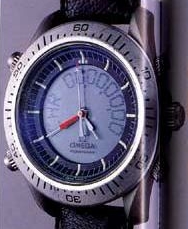
|
The
original (vintage) Flightmaster series
consisted of two distinct versions each with
a number of dial variants within each
version. In addition to the two main versions
there was a special solid Gold version of one
model... Here is a picture from
Eric
Katoso's site
of each version:
|
-
|
As the
c.911 (ST145.036)is closer to a main
line Speedmaster Professional Moonwatch, I'll
describe them out of order...
|
|
The
Flightmaster c.911 (ST145.036)
uses the c.861 base Omega manual-wind
movement with a 12-Hour GMT hand
complication. The hand moves and is set
uni-directionally via the auxiliary crown
located at 10 o'clock on the case. The crown
located @ 8:30 on the case set's the under
mineral crystal bezel.
|
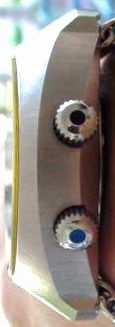
|

|
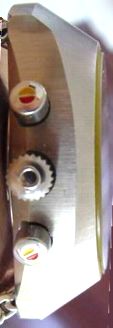
|
Left
side of a c.911 case.
|
- Right
side of a c.911 case.
|
|
--
Both the photo's of the side of the c.911
case are courtesy of Kris
Chantanotoke
|
|
|
|
Originally from
the Omega factory in Bienne, Switzerland, the
Auxillary Crowns on the left side of the
case
(above left)
have a circular indentation in them and are
color coded to their function... Blue for the
second hour hand, black for the under crystal
bezel. Over time this paint can flake out or
due to replacement with a conventional crown,
not appear at all. In addition, the pushers
on the right side of the watch
(above
right)
also have indentations on them as well and
have yellow/orange paint on them. These are
color-keyed to the sub-register hands that
indicate chronograph elapsed time. Like the
auxillary crowns the paint can flake and on
many examples have been replaced with plain
pushers... This color coding is consistant
through out the Flightmaster line as shipped
from the factory. Watches with paint and
original crowns/pushers intact are worth more
than a Flightmaster in otherwise comparable
condition without...
Aside from this
the operation of the watch is the same as the
moonwatch with a similar power reserve, etc.
WR rating from the factory is 60 meters
according to sales literature of the era.
This is in no small part due to the use of a
mineral glass crystal instead of a plastic
crystal on the moonwatch.
|
|
With
the The Flightmaster c.910 (ST145.013)
the base c.861 Omega manual-wind movement is
modified by replacement of the small seconds
sub-register at 9 o'clock and with a 24-Hour
AM/PM indication. Operation is the same as
the c.911 above but with the omission of the
small second indicator there is no way to
determine at a brief glance if the watch is
ticking unless the chronograph is in
operation.
Here is a
picture of my c.910
Flightmaster:
|
- Scans
from a c.910 Flightmaster instruction
manual:
- (information courtesy
of Stuart Tentoni)
Produced
by people with their feet firmly on the
ground.
|
|
It's
easy to produce a chronograph with a
revolving bezel and then call it a pilot's
watch.
It's
not so easy to produce a functional
chronograph specifically for the
pilot.
Before
we even started to design the Flightmaster we
researched the needs of the pilot and then we
made sure that we covered those needs - no
more, no less.
The
result is the combined effort of designers
already experienced in producing chronographs
for the aviation world; and Omega - supremely
experienced in the production of precision
timepieces which have proved reliable even in
the extreme conditions of space
travel.
Every
part of the Flightmaster has been carefully
considered and the chronograph born of the
research design and development is a
practical instrument - specially made for the
pilot.
|
|
- The
Case:
Cut
from a single block of Swedish stainless
steel, the upper case is pressed and
tempered sixteen times before it assumes
it's unique elliptical shape designed to
fit the countours of the wrist
comfortably.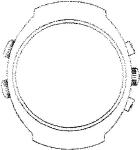 Normally,
the Flightmaster is equipped with a
stainless steel bracelet. But it also
comes with a Corfam® strap. The strap
has cool "air-conditioning" holes and is
designed with the anatomy of the wrist in
mind to assure a firm and comfortable fit
necessary with a watch of the
Flightmaster's
proportions. Normally,
the Flightmaster is equipped with a
stainless steel bracelet. But it also
comes with a Corfam® strap. The strap
has cool "air-conditioning" holes and is
designed with the anatomy of the wrist in
mind to assure a firm and comfortable fit
necessary with a watch of the
Flightmaster's
proportions.
|
|
 - Water
and Spaceproofing:
- After
the movement has been inserted into the
case and the stainless steel back screwed
into place, the tempered mineral glass
crytstal is sealed in position by a unique
jointing system.
It has
been tested under space conditions and works
even in a complete vacuum
.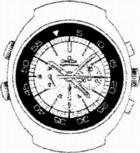
- Legibility:
- A
pilot's watch has many functions so the
visual aspect of the Flightmaster is a
particular feature.
|
|
Designed
for legibility the time zone hand have been
carefully placed to avoid confusion with the
whole face colour keyed to strengthen the
visual separation.
Even
the winders and pushpieces have been keyed to
the face and although the red chronograph
hands are supplied as standard, the
Flightmaster is on special request available
with yellow hands to allow for where aircraft
cabins are lit with infra-red
light.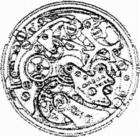
The
Movement:
The same people responsible for the
timeing devices used in the Olympics and by
the American astronauts are responsible for
the Flightmaster so you knoiw that each of
the moveing parts is a piece of precision
engineering designed for accuracy and total
reliability.
|
|
Overall usage... The
basics:
 - Click
to enlarge
photos...
|
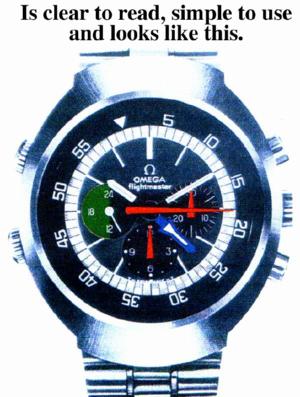
|
Chronograph Operation:
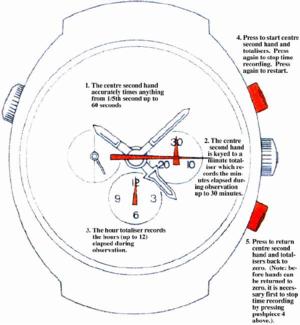 - Click
to enlarge
photos...
|
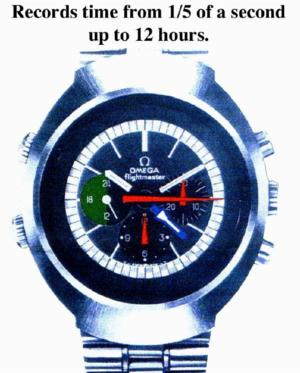
|
GMT or Multiple Time Zone
Operation:
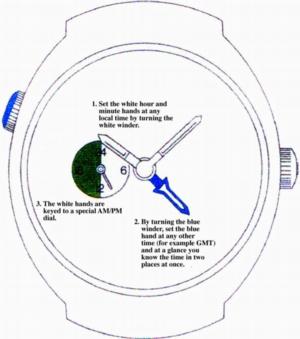 - Click
to enlarge
photos...
|
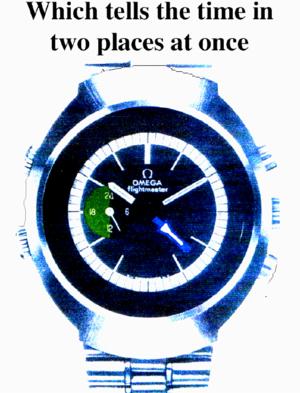
|
Operation of the undercrystal
Bezel:
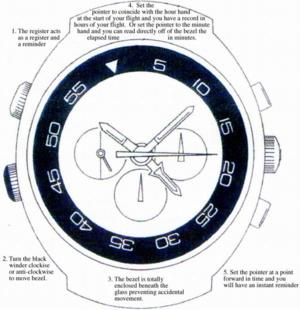 - Click
to enlarge
photos...
|
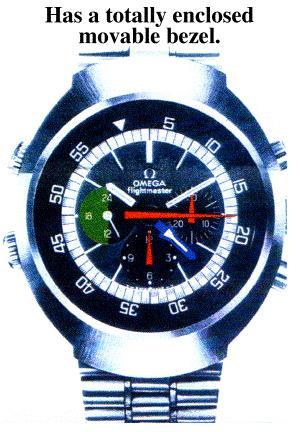
|
-
|
The Flightmaster
has an somewhat undeserved reputation as
being a "Monster-sized" watch. Yes if you
look at the Flightmaster's exterior
dimensions it is a large watch. However,
similar to the Fender Stratocaster, the
Flightmaster's shape and taper actually fits
and blends in with the back of the wrist well
and wears better than many smaller watches,
well... at least in my opinion. Part of the
reason for this are the hidden lugs of the
Flightmaster case... The c.910 AM/PM model's
dimensions are modest enough that it actually
wears smaller than it's dimensions would
otherwise seem. However, the thicker c.911
Small Seconds model wears just as large as
it's dimensions would indicate.
The hidden lugs
can be seen via the picture of the movement
below left. While it's clear to see the case
of the watch is smooth from the top,
underneath there is a slot where the
bracelet/strap attaches. Visually the
movements for both the c.910 and c.911 look
almost exactly the same. As I don't own an
example of each it's difficult for me to
compare the two visually. Of course both
movements clearly show their heritage of
being based on the c.861 Omega movement
(Lemania 1873 base movement).
|
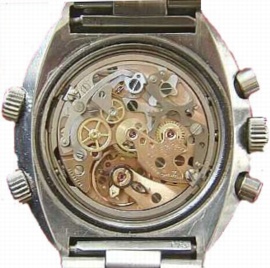
|
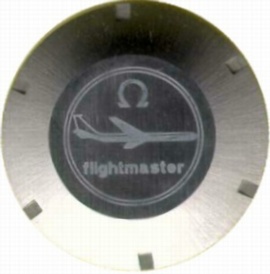
|
|
Flightmaster
c.910 Movement
|
Flightmaster
Caseback
|
|
Another common
feature across the Flightmaster line is a
unique design on the caseback. Which consists
of an Omega Symbol (logo), a jetliner (looks
to my eye to be a DC-8 Super 61), and the
name "flightmaster". Note that "flightmaster"
is not capitalized on the
caseback or on the dial. I don't really know
why it was not, but it is an interesting item
for conversation.
The jetliner on
the caseback leaves no doubt to the market's
this watch was positioned to sell
to.
|
|
Flightmaster
c.910/Flightmaster c.911
side-by-side:
The following
are side by side pictures of my two
flightmaster examples...
|
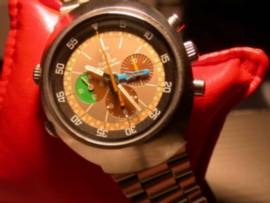
|

|
|
Left:
Omega Flightmaster c.910
(ST145.013)
|
Right:
Omega Flightmaster c.911
(ST145.036)
|
|
|
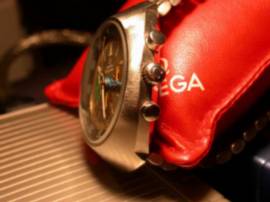
|

|
|
Left:
Omega Flightmaster c.910
(ST145.013)
|
Right:
Omega Flightmaster c.911
(ST145.036)
|
|
|
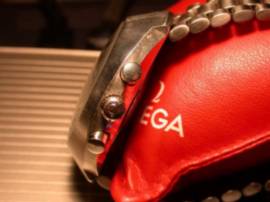
|
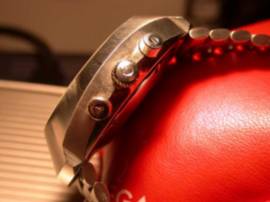
|
|
Left:
Omega Flightmaster c.910
(ST145.013)
|
Right:
Omega Flightmaster c.911
(ST145.036)
|
|
|
|
Dimensions
of Omega Flightmaster
|
|
Ref.#:
|
Calibre:
|
Description:
|
Length:
|
Width
w/Crown:
|
Width
w/o Crown:
|
Thickness:
|
Weight:
|
|
ST145.013
|
c.910
|
Flightmaster
c.910
|
52.25
mm
|
45.55
mm
|
42.6
mm
|
14.65
mm
|
139.0
g
|
|
ST145.036
|
c.911
|
Flightmaster
c.911
|
52.25
mm
|
45.55
mm
|
42.6
mm
|
15.65
mm
|
139.0
g
|
- BA345.0801
|
c.910
|
YG
Flightmaster c.910
|
52.25
mm
|
45.55
mm
|
42.6
mm
|
14.65
mm
|
+/-250g
|
|
Note:
Weights are with Omega Bracelets of the same
material as the case...
|
|
The Flightmaster
took it's bow in 1969 and production ran for
several years. The stainless steel
Flightmasters range in value from $500 or so
to $1,300 for a minty condition
examples.
The
Gold Flightmaster c.910
(ST145.013/345.80)

|
The
Gold Flightmaster c.910
(ST145.013/345.80) along with
the Solid gold Seamaster
Professional Chronograph, is among
the heaviest watches that Omega has
ever produced. Estimates of a Gold
Flightmaster on a Gold Bracelet's
heft being in the 240-260 gram range
(as shown to the right in a Japanese
Language book on Omega
Chronographs)... Part of this weight
is due to the increased weight of
the case, part is due to the gold
caseback.
|
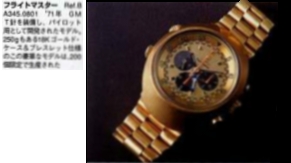
|

|
|
--
Gold Flightmaster photo courtesy of
Kris Chantanotoke
|
Eric
Katoso's site
has a page for each of the three Flightmaster
versions and on the Gold
Flightmaster page
Eric says that he has been told that the Gold
Flightmaster production run may have been as
few as 40 pieces... So the Gold model is very
hard to come by and typically fetches a price
in the several thousand dollar range when
they do appear ($3,000 +)...
|
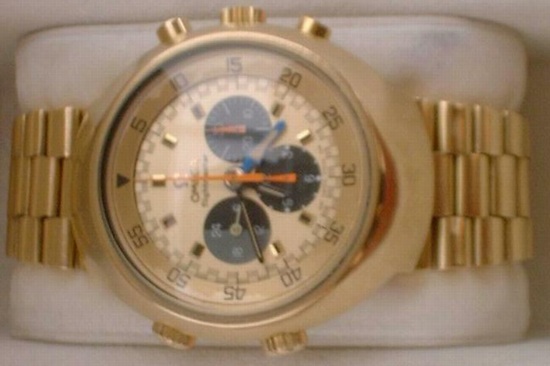
|
|
A
gold Flightmaster c.910 from the
eBay.de
auction site. Sorry about the quality but you
take what you can get...
|
- Soviet
Flightmaster Connection:
|
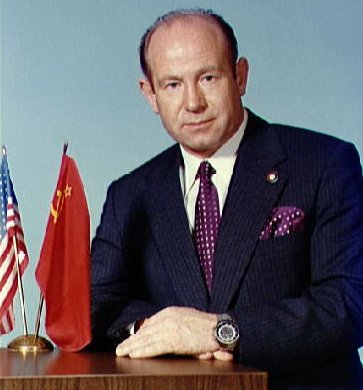
|
|
|
|

|
|
|
|
|
|
One of the
benefits of Detente between the Soviet Union
and the United States was the Apollo-Soyuz
Test Project (ASTP), and one of the
"trickle-down" effects of the Apollo-Soyuz
mission was that Soviet Astronauts had access
to Swiss Chronographs to wear for a space
mission for the first time. At right
is an official NASA picture of Cosmonaut
Aleksey Leonev wearing his Flightmaster which
appears to be a Stainless Steel c.911
(ST145.036) model.
|
|

|

|
|
ASTP
Painting
by Bert Winthrop of Rockwell
|
|
|
|
- Clockwise
from the ASTP emblem:
- Astronaut
Thomas P. Stafford,
- Apollo
Commander;
- Astronaut
Donald K. Slayton,
- Apollo
Docking Module Pilot;
- Astronaut
Vance D. Brand,
- Apollo
command Module Pilot;
- Cosmonaut
Valeriy N. Kubasov,
- Soyuz
Engineer;
- Cosmonaut
Aleksey A. Leonov,
- Soyuz
Commander.
|
|
Aleksey
A. Leonov practices with a training mock-up
of the ASTP commemorative medal during Apollo
Soyuz Test Project (ASTP)
|
|
A "Flat"
Flightmaster Mystery...
- In addition
to these widely known examples of the
Flightmaster there occasionally appears on
the market, typically on
eBay
another watch claiming to be of the
Flightmaster linage. This watch is
pictured below at left.
|
- I have never
seen an example like this in any Omega
Literature or any book on Omega's that I
feel to be authoritative. I am all but
convinced that this watch is not a model
that was ever produced by Bienne, but
rather a Flightmaster dial retrofitted
into a Seamaster case. Specifically the
case of a Seamaster ST
145.019...
The problem with
the "Flat" Flightmaster is that it does not
include a vital part of the Flightmaster
feature set: the second hour hand. While the
"Flat" Flightmaster does include the under
crystal bezel, the lack of the second hour
hand, and lack of official literature seems
to indicate a less legitimate origin for
these examples. I would not recommend taking
a chance on purchasing such a "rare" and
probably put-together version.
|
|
18
September 2005 Addendum:
"Photohorologer"
Ming Thein contacted me yesterday with a slew
of outstanding and dramatic flightmaster
photo's he had taken of a new flightmaster
c.911 acquisition of one of his cousin's...
Ming's cousin was gracious enough to let Ming
photograph his flighty, and Ming was kind
enough to permit me to share them with you
all. With out further ado here they are:
|
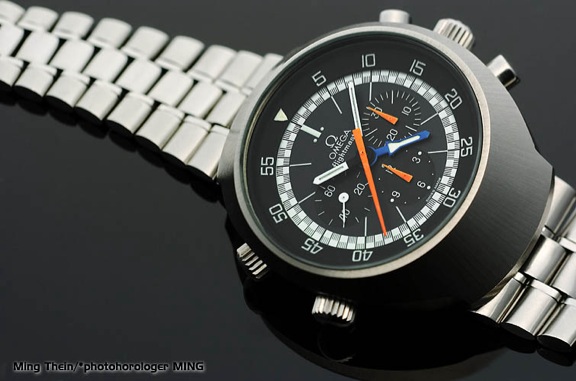 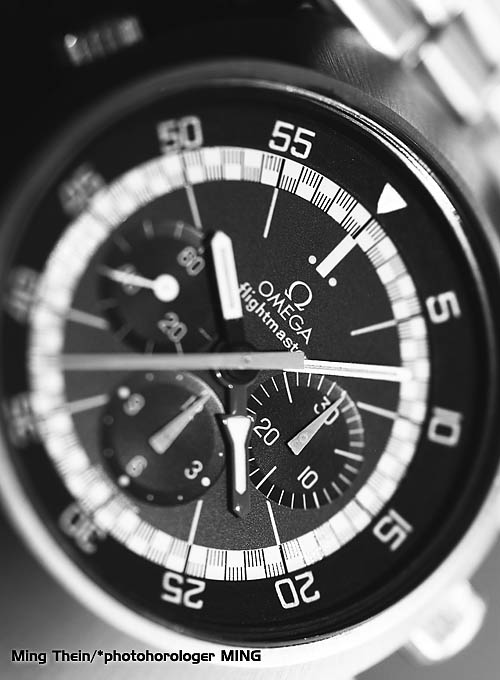   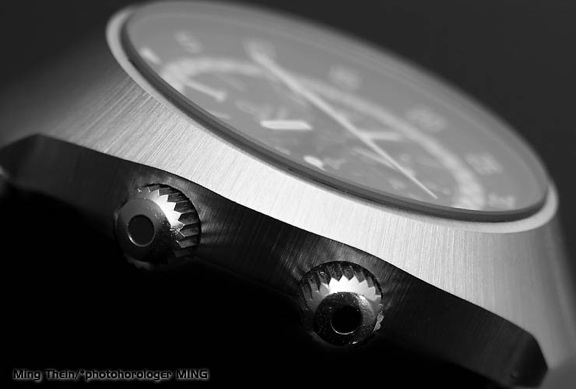  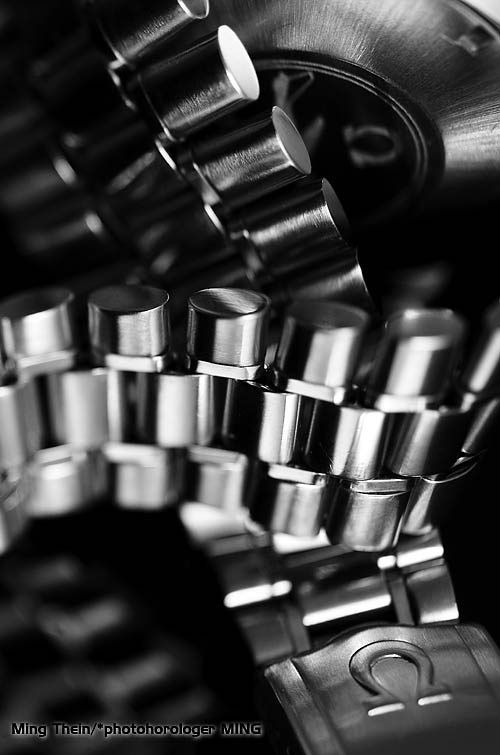
- Acknowledgments...
I would like to
thank Eric Katoso for his contribution
of the photograph of the c.910 and c.911
Flightmasters and the Seamaster ST 145.019...
Visit
his excellent site to learn much more about
Vintage Omega's...
I would also
like to thank Kris Chantanotoke for his
contribution of several phtotographs included
in this article. The section on the crowns
and pushers looked much different before
Kris's contributions...
The addition of
Ming Thein's photography of his cousin's
flighty c.911 adds a great deal to this
article, thanks to both Ming and his cousin
for making possible their
inclusion!
Lastly, I would
like to thank Dr. Stuart Tentoni for his
mailing color printouts of materials he
received from Omega.ch way in advance to this
article. His contributions add greatly to the
usefulness of this article...
The photo's
included in the section on Alexei Leonov are
courtesy of the NASA web site.
|
- Statement
of rights retained and permissions
granted...
-
- Permission
is granted for Eric Katoso, Damon, Derek
Ziglar, Frank N., Ross or Robert Jan to
include portions within the FAQ's they are
writing as long as credit (and a link to
this article) is given. Permission for
personal, educational or noncommercial use
is granted. The author retains all other
rights not specifically mentioned here...
For all other use please contact the
author.
-
- Disclaimer:
Opinions are my own and knowing me should
be taken with a grain or two of
salt...
|
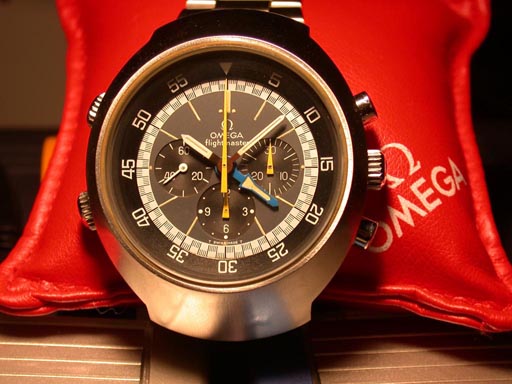
|